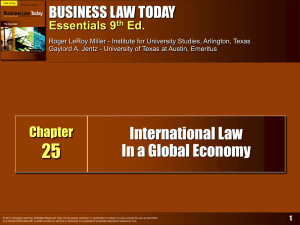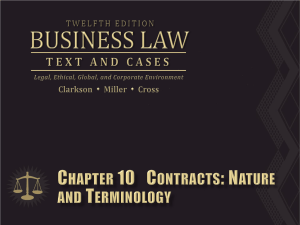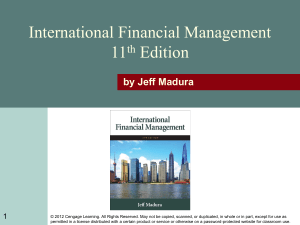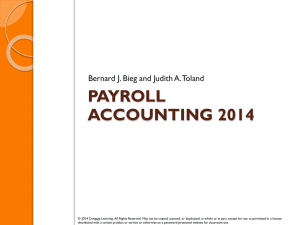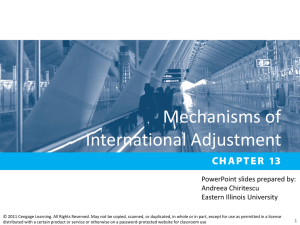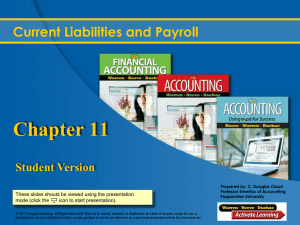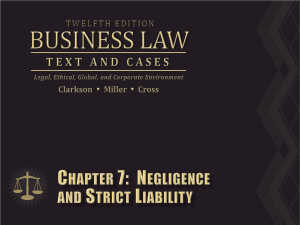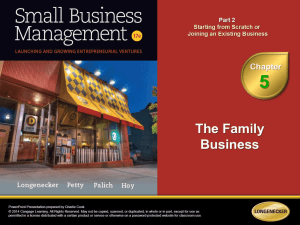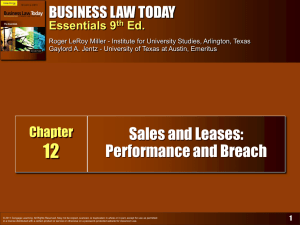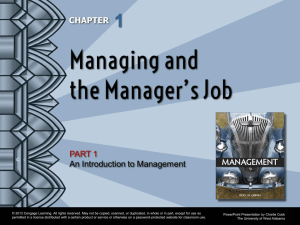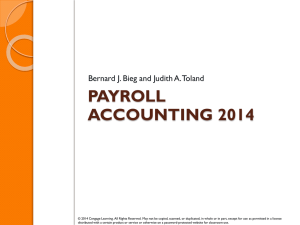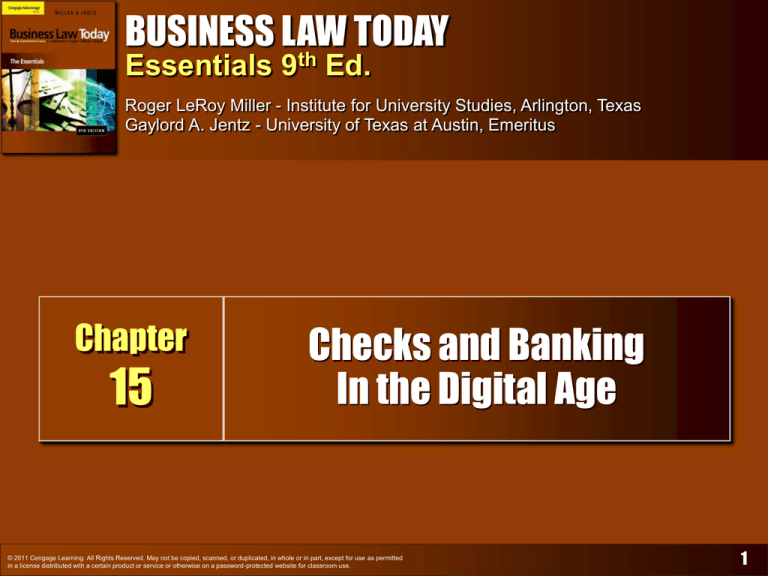
BUSINESS LAW TODAY
Essentials 9th Ed.
Roger LeRoy Miller - Institute for University Studies, Arlington, Texas
Gaylord A. Jentz - University of Texas at Austin, Emeritus
Chapter
15
Checks and Banking
In the Digital Age
© 2011 Cengage Learning. All Rights Reserved. May not be copied, scanned, or duplicated, in whole or in part, except for use as permitted
in a license distributed with a certain product or service or otherwise on a password-protected website for classroom use.
1
Learning Objectives
What type of check does a bank agree in advance to
accept when the check is presented for payment?
When may a bank property dishonor a customer’s
check without liability to the customer?
What duties does the UCC impose on a bank’s
customers with regard to forged and altered checks?
What are the consequences if a customer is
negligent in performing those duties?
What are the four most common types of electronic
fund transfers?
What laws apply to e-money transactions and online
banking services?
© 2011 Cengage Learning. All Rights Reserved. May not be copied, scanned, or duplicated, in whole or in part, except for use as permitted
in a license distributed with a certain product or service or otherwise on a password-protected website for classroom use.
2
Cashier’s Checks
Cashier’s Check—bank is both drawer
and drawee.
CASE 15.1 MidAmerica
Bank, FSB v. Charter
One Bank (2009). Bank
must pay cashier’s check
over the drawee’s stop
payment order which is
wrongful under UCC 3411.
© 2011 Cengage Learning. All Rights Reserved. May not be copied, scanned, or duplicated, in whole or in part, except for use as permitted
in a license distributed with a certain product or service or otherwise on a password-protected website for classroom use.
3
Traveler’s Checks and Certified Checks
Traveler’s Check—payable on demand,
payable by a financial institution,
designated as a traveler’s check.
Certified Checks—accepted in writing by
drawee bank.
© 2011 Cengage Learning. All Rights Reserved. May not be copied, scanned, or duplicated, in whole or in part, except for use as permitted
in a license distributed with a certain product or service or otherwise on a password-protected website for classroom use.
4
The Bank-Customer Relationship
Creditor-Debtor: Bank owes money to
customer and must honor customer’s
checks.
Agency Relationship: Bank must pay
customer’s checks and collect for
customer if she deposits checks.
Contractual Relationship: specific rights
and duties depend on the terms of the
transaction.
© 2011 Cengage Learning. All Rights Reserved. May not be copied, scanned, or duplicated, in whole or in part, except for use as permitted
in a license distributed with a certain product or service or otherwise on a password-protected website for classroom use.
5
Bank’s Duty to Honor Checks
Banks that wrongfully dishonor
customer’s checks are liable for actual
damages only.
Overdrafts: bank’s choice to honor or
not, then hold customer liable for
amount.
Postdated Checks: Bank can pay unless
notified in time to act on it.
© 2011 Cengage Learning. All Rights Reserved. May not be copied, scanned, or duplicated, in whole or in part, except for use as permitted
in a license distributed with a certain product or service or otherwise on a password-protected website for classroom use.
6
Bank’s Duty to Honor Checks
Stale Checks: after 6 months, it is bank’s
choice whether to honor or not.
Stop-Payment Orders:
Customer can’t stop certified checks and must give
bank enough time to act.
Oral Stop Payment = 14 days, Written = 6 months.
Bank’s Liability for Wrongful Payment: Bank is
obligated to recredit account, plus all ‘bounced’ costs.
Customer's Liability for Wrongful S.P. Order: Must
have valid legal ground, but is still liable to payee for
damages.
© 2011 Cengage Learning. All Rights Reserved. May not be copied, scanned, or duplicated, in whole or in part, except for use as permitted
in a license distributed with a certain product or service or otherwise on a password-protected website for classroom use.
7
Bank’s Duty to Honor Checks
Death or Incompetence of a Customer:
Bank can pay until it knows and can pay checks
drawn before death or incompetence 10 days
after it knows - unless notified by a family
member or executor.
© 2011 Cengage Learning. All Rights Reserved. May not be copied, scanned, or duplicated, in whole or in part, except for use as permitted
in a license distributed with a certain product or service or otherwise on a password-protected website for classroom use.
8
Checks Bearing Forged
Drawers’ Signatures
General Rule: forged signature has no
legal effect, and bank must recredit
customer’s account.
Customer Negligence: if customer
substantially contributes to forgery, bank
will not have to recredit the account.
CASE 15.2
Auto-Owners Insurance Co. v.
Bank One (2008). Bank One did not breach a duty
to Auto-Owners and did not substantially contribute to
the loss when it opened the account .
© 2011 Cengage Learning. All Rights Reserved. May not be copied, scanned, or duplicated, in whole or in part, except for use as permitted
in a license distributed with a certain product or service or otherwise on a password-protected website for classroom use.
9
Checks Bearing Forged
Drawers’ Signatures
Customer Negligence (cont’d)
Timely Examination of Bank Statements Required.
Customer has a duty to promptly examine
statements and report any forgeries or alterations,
usually within 30 days.
Consequences of Failing to Detect Forgeries. Bank
is not liable for all forged checks it pays prior to the
notification.
When the Bank is Also Negligent.
Bank fails to exercise ordinary care, in keeping with
established banking standards.
Regardless of bank’s care, UCC places absolute
time limit on liability for forged check: ONE YEAR.
© 2011 Cengage Learning. All Rights Reserved. May not be copied, scanned, or duplicated, in whole or in part, except for use as permitted
in a license distributed with a certain product or service or otherwise on a password-protected website for classroom use.
10
Checks Bearing Forged Indorsements
Payment on a Forged Indorsement – if
not to customer’s order, bank must recredit unless customer is negligent
before or after forgery.
Before forgery: if large gaps or
incompleteness.
After forgery: customer must notify bank (i)
within 3 days after forged items made available
to customer, or (ii) if a series of forgeries,
within 30 days of receipt of either the bank
statement or canceled checks.
© 2011 Cengage Learning. All Rights Reserved. May not be copied, scanned, or duplicated, in whole or in part, except for use as permitted
in a license distributed with a certain product or service or otherwise on a password-protected website for classroom use.
11
Checks Bearing Forged Indorsements
Bank may recover from the person it paid
(not cashier, teller, or certified checks) if
Warranty. Presenter did not have Good
Title because of the forged indorsement.
© 2011 Cengage Learning. All Rights Reserved. May not be copied, scanned, or duplicated, in whole or in part, except for use as permitted
in a license distributed with a certain product or service or otherwise on a password-protected website for classroom use.
12
Altered Checks
Altered Checks.
Bank has implied duty to inspect checks.
Customer Negligence shifts loss to customer
if bank pays in good faith without notice.
Bank may recover from other parties.
© 2011 Cengage Learning. All Rights Reserved. May not be copied, scanned, or duplicated, in whole or in part, except for use as permitted
in a license distributed with a certain product or service or otherwise on a password-protected website for classroom use.
13
Bank’s Duty to Accept Deposits
Expedited Funds Availability Act (1987)
and Regulation CC:
Local checks, 1 day availability.
Non-local checks, not more than 5 days.
© 2011 Cengage Learning. All Rights Reserved. May not be copied, scanned, or duplicated, in whole or in part, except for use as permitted
in a license distributed with a certain product or service or otherwise on a password-protected website for classroom use.
14
Traditional Collection Process
Designations of Banks in Process.
Depositary Bank: first bank to receive payment.
Payor Bank: on which check is drawn.
Intermediary Bank: other banks in collection
chain.
© 2011 Cengage Learning. All Rights Reserved. May not be copied, scanned, or duplicated, in whole or in part, except for use as permitted
in a license distributed with a certain product or service or otherwise on a password-protected website for classroom use.
15
Traditional Collection Process
Local checks: one business day from the date
of deposit.
Non-local checks: five business days from the
date of deposit.
Some deposits must be available the next
business day.
Deposits made in non-proprietary ATMs: 5
business days.
Some exceptions for new-customer deposits
and large deposits.
© 2011 Cengage Learning. All Rights Reserved. May not be copied, scanned, or duplicated, in whole or in part, except for use as permitted
in a license distributed with a certain product or service or otherwise on a password-protected website for classroom use.
16
Traditional Collection Process
© 2011 Cengage Learning. All Rights Reserved. May not be copied, scanned, or duplicated, in whole or in part, except for use as permitted
in a license distributed with a certain product or service or otherwise on a password-protected website for classroom use.
17
The Traditional Collection Process
Bank must present check to be paid on
or before midnight of the next day
following receipt.
“Deferred posting” bank can set e.g.,
2:00 pm as cutoff hour.
Bank can dishonor the check by the
opening of the second banking day
following its receipt or check is
considered paid.
© 2011 Cengage Learning. All Rights Reserved. May not be copied, scanned, or duplicated, in whole or in part, except for use as permitted
in a license distributed with a certain product or service or otherwise on a password-protected website for classroom use.
18
The Traditional Collection Process
Each bank in the collection process must pass
the check on before midnight of the next
banking day following its receipt.
Payor bank must dishonor or return it by
midnight on the next banking day following
receipt, or the payor bank is accountable for
the face amount of the check.
CASE 15.3 Bank One, N.A. v. Dunn. (2006).
Bank was not liable to its customer for delay in
determining whether the check was counterfeit.
© 2011 Cengage Learning. All Rights Reserved. May not be copied, scanned, or duplicated, in whole or in part, except for use as permitted
in a license distributed with a certain product or service or otherwise on a password-protected website for classroom use.
19
How the Federal Reserve
System Clears Checks
Fed acts as a Clearinghouse.
Electronic Check Presentment.
Much faster in contrast to manual check
processing.
Check may not be physically moved, but
encoded information sent by computer.
Those parties who encode and notify make
the same warranties as if the check were sent
physically
© 2011 Cengage Learning. All Rights Reserved. May not be copied, scanned, or duplicated, in whole or in part, except for use as permitted
in a license distributed with a certain product or service or otherwise on a password-protected website for classroom use.
20
Electronic Fund Transfers
Types of EFT Systems.
ATMs.
Point-of-Sale systems.
Direct deposits and withdrawals.
Internet Payment Systems.
Consumer Fund Transfers: governed by
Electronic Fund Transfer Act of 1978.
Loss limited to $50.00.
Commercial Fund Transfers: governed by
Article 4A of the UCC.
© 2011 Cengage Learning. All Rights Reserved. May not be copied, scanned, or duplicated, in whole or in part, except for use as permitted
in a license distributed with a certain product or service or otherwise on a password-protected website for classroom use.
21
E-Money and Online Banking
Digital Cash (e-money) in smart cards.
Online Banking Services.
Online contract between bank and customer
governs terms.
Regulatory Compliance.
Privacy Protection.
Electronic Communications Privacy Act (1986).
Consumer Financial Data: Gramm-Leach-Bliley
Act (1999).
© 2011 Cengage Learning. All Rights Reserved. May not be copied, scanned, or duplicated, in whole or in part, except for use as permitted
in a license distributed with a certain product or service or otherwise on a password-protected website for classroom use.
22

